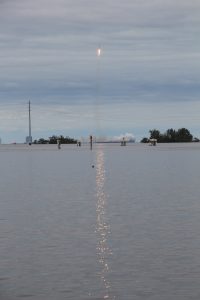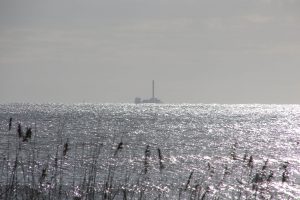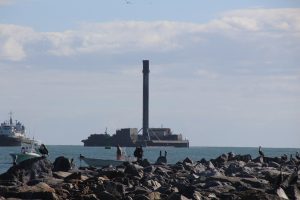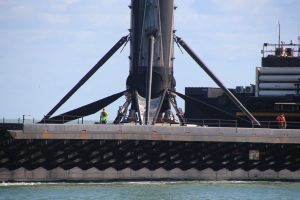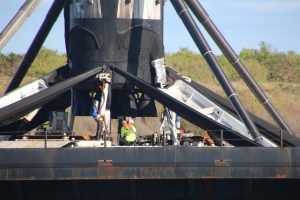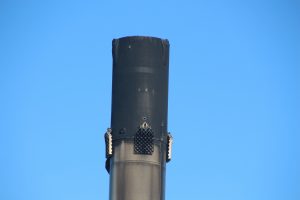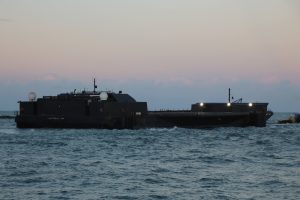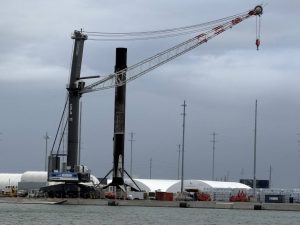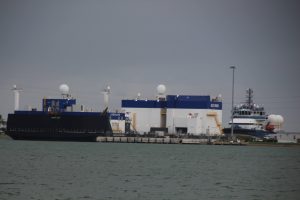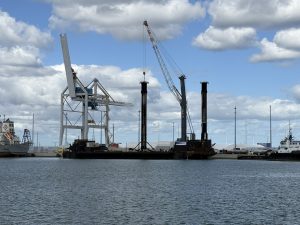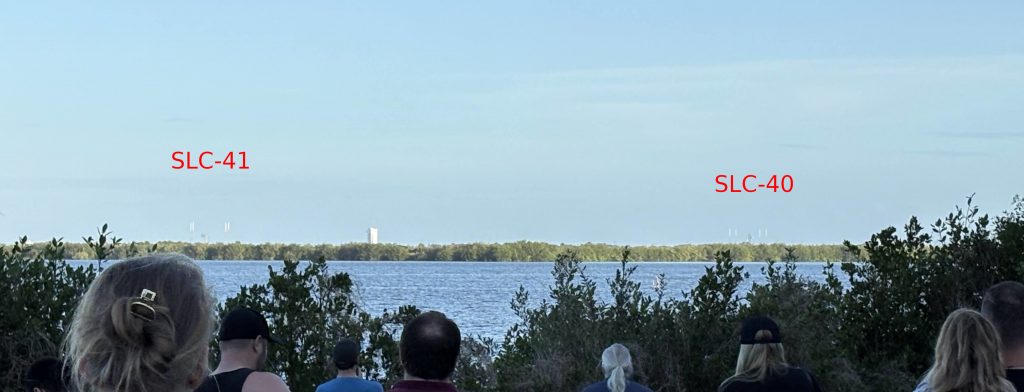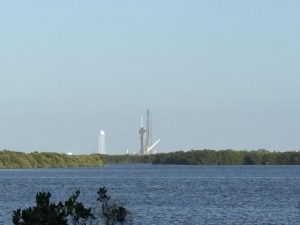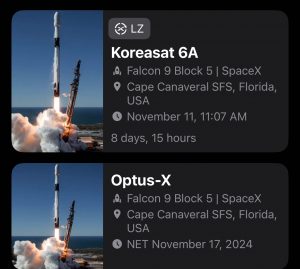We visited the Florida Space Coast last in November 2024 and had a fantastic experience. The dates for the trip were drawn up a couple of months in advance of any firm rocket launch expectations, but with the cadence of Falcon 9 these days we crossed our fingers and hoped to see a launch.
Then we saw five in the span of a week!
Watching a rocket launch is awe inspiring, and I highly recommend it. My goal today is to enable you too to enjoy a visit to the Space Coast and feel the power of a Falcon 9 rocket launch. I want to share what I learned through many hours of anxious/excited reading about where & how exactly to view a rocket launch with the hope that you’ll be more informed.
I learned a lot of this information from other sites – notably:
- Rocket Launch Viewing Guide – Ben Cooper Photography – the best resource I found. It took me a while to absorb it all – his explanations are thorough, and one complex question I wanted to answer to try and make a viewing decision I derived by reading the entire page (where to go view a RTLS launch)
- Launch Rats – an older guide which is primarily useful in it’s gauge of distances from viewing sites to launch pads.
When viewing a launch, indispensable is the Next Spaceflight app: the countdown clock is particularly useful. Duh. But as someone who’s grown accustomed to watching launches on YouTube where your delay from reality doesn’t much matter, a properly timed countdown clock is essential. They also do a good job of updating launch times as launches are inevitably delayed. More on launch scheduling later.
One hard thing I’ll try to help with: there are a lot of launch towers! From any reasonable distance it can be hard to distinguish one launch pad from another. I found myself comparing views of supporting infrastructure on NSF live streams and eyeballing the compass direction in Google Maps against target launch pads to make sure I am looking at the right pad. I kid you not – one time I had a 300mm zoom lens trained on the wrong pad at liftoff. Oops!
We saw five launches of rockets from LC-39A and SLC-40 but I’ll list them by where we watched from, what you can expect, and where to look:
Route 528 – LC-39A + RTLS to LZ1 and SLC-40
We chose to watch two launches from a pull-off spot on Route 528 over the Banana River. The first launch we saw was on LC-39A with a landing on LZ1, and Route 528 is a good trade off between being able to see a clear view of the launch pad and a view of the returning booster down to LZ1. It’s 14 miles to LC-39A, 12 miles to SLC-40, but only 8 miles to LZ1.
It is – however – not a single location. The spot I recommend is here – the second pulloff when you drive westbound on Route 528 over the river. Don’t be afraid to drive slow despite warnings of crazy Florida drivers – 1/100 cars on the road are also pulling over to find a spot to watch the launch, and there’s actually a lot of space to park. You’ll find yourself in great company – at least a few fellow space nerds will be camped out here.
Beware of the first pulloff here. You’ll find people here who plan to watch the launch – but – LC-39A is obscured by a small green island. Other pads are visible and you might be inclined to stay. We spent a half hour here before realizing we couldn’t see what we wanted to see and driving over to the next spot.
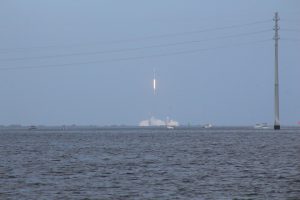
Falcon 9 launch from LC-39A with Koreasat 6a on board. Hazy day and you can hardly make out the Starship launch tower.
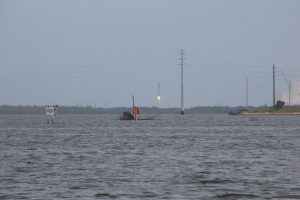
Falcon 9 landing at LZ1 of Koreasat 6a’s booster B1067. Note that there are no obvious landmarks of the landing zone; there are no towers. You can also check out a little cheesy animation from Google Photos which is fun. If we were at the next pull-off east on Route 528, the booster landing would have been obscured by Port Canaveral buildings.

Panoramic view from Route 528 location I described above showing which pad is where. LZ1/2 landing spot is off to the right.
Launches we watched from here:
- Mon Nov 11, 2024 – Falcon 9 LC-39A + RTLS – Koreasat 6A
- Mon Nov 18, 2024 – Falcon 9 SLC-40 – GSAT-20
Titusville – Casa Coquina or Kirk Point park
We wanted to watch this particular LC-39A launch from Playalinda beach but at the national park entrance 90 minutes before launch was a park ranger forbidding access to cars. Since we were staying in Titusville anyway and the BnB (Casa Coquina) has a second floor viewing platform, we decided to just go back there. It was a good show, at 12 miles away. For photographer purists, I’d recommend walking over to the water front – I was dodging power lines around my photos and editing them back out later.
Titusville offers lots of spots to watch along the west side of the Indian River and they’re all pretty comparable. The Max Brewer Bridge is frequently mentioned – but I opted against it because there is some new building construction blocking a couple of viewing spots, and also because it’s a mile long bridge – which means you’re walking half a mile. Granted it’s in a concrete-blocked off pedestrian walkway – but it means that as you catch your breath from the walk up the bridge (breathing car exhaust fumes!) you’re also going to be trapped – there’s nowhere to move around while you wait for a launch. I have two little kids who would’ve gone nuts being here, next to traffic, and the launch was delayed by an hour. I’m glad I didn’t stop. Serious photographers won’t mind this, but dads might!
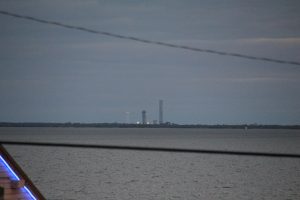
LC-39A just before liftoff, viewed through a 300mm zoom lens. The dark black tower in the middle, same height as the water tower, is the F9 launch tower. The larger tower on the right is the Starship/Super Heavy launch tower which is close by, southeast of the F9 tower.
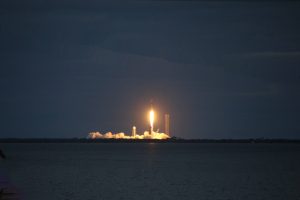
Falcon 9 just after liftoff. Beautiful glow on the exhaust gases below. I edited out the power lines in view.
Launch we saw from here: Sun Nov 17, 2024 – Falcon 9 LC-39A – Optus-X/TD7
What you can see from Port Canaveral
One of our launches was scheduled for 5:15 AM, the morning after a marathon 14 hour day at Disney when I didn’t go to bed until 1 AM. I dutifully woke to my alarm at 4:30 to check the countdown clock, and it had been postponed by only 15 minutes to ~5:30 AM. Since it appeared on-time, I carried sleeping kids to the car and drove to Route 528 hoping for a beautiful night sky liftoff…all for SpaceX to punt the launch at T-5 minutes. Reports I read indicated that this call had been made much sooner, but being a 5 AM launch, NASA Spaceflight and Spaceflight Now were not quite awake to notice that SpaceX hadn’t even fueled the vehicle. We went back to our hotel near Port Canaveral and slept a few more hours, and watched the launch from SLC-40 with no pad view from the hotel’s 5th floor balcony on the other side of the port. It still sounds amazing and is awe inspiring even when it’s not a great view!
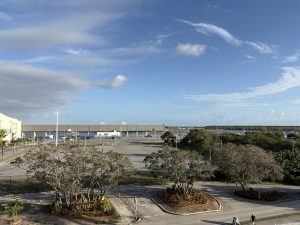
View from the 5th floor of our hotel just south of the Port Canaveral area. The port loading buildings obscure any pad views, but of course you can see the sky.
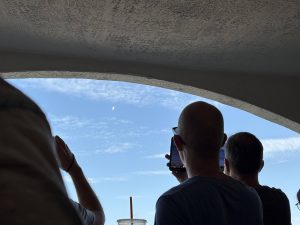
Starlink finally launches after waking me up at 4:30 AM. I didn’t bother to get the proper camera out for this and ended up behind a couple of rows of other viewers. Enjoyable sound, not the best view. Also made me acutely aware of the fact that looking at the pad is different than looking at the full flight trajectory – we all lost view of the rocket 60 seconds after liftoff because it was east and above us.
Launch we saw from here: Thu Nov 14, 2024 – Falcon 9 SLC-40 Starlink 6-68
Booster Return: Jetty Park
Our hotel was walking distance to Jetty Park, which worked out well as you can see two things from here – both boosters returning with the drone ship comes into the port, and you can drive through Port Canaveral across from the unloading docks where SpaceX lifts used boosters off the ship and get a pretty good view of a booster. NSF’s Space Coast Live stream keeps an eye on the booster unloading dock and often a camera will pan over to watch the procession down the canal. But I recommend making the time to watch one come in – it’s the closest you’ll get to look at a production Falcon 9 booster.
To know when to find a booster coming in, get an account with Marine Traffic and look up MARMAC 302 (A Shortfall of Gravitas) and MARMAC 303 (Just Read The Instructions). MARMAC 304 is Of Course I Still Love You, currently stationed on the west coast, but that may change by the time you read this. When out at sea to catch a booster (typically about 600km downrange north of the Bahamas) it is out of terrestrial AIS range; if you can swing a paid account you can use their satellite tracking feature, but this isn’t strictly necessary. Weather permitting the booster will come in about 36-48 hours after a landing, and will come in terrestrial (free) AIS range at least an hour away from the port. It comes in slowly under power of a tug at 7-9 knots; the procession from a blip on the horizon to up-close on the canal took nearly two hours and it takes another 30 minutes down the canal into the port to their dock.
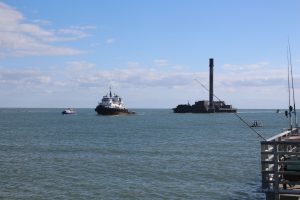
It had never occurred to me that drone ships are pulled by a tug. The entire way to the Bahamas and back, Signet Warhorse III pulls JRTI.
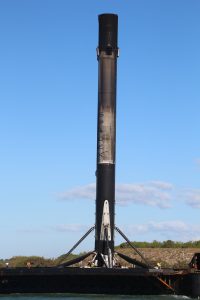
B1076. An odd thing for a photographer – not having to use much of my zoom lens because the rocket is so close!
Drone ships also go back out to sea empty of course – about two days ahead of a launch; during my visit, the drone ships turned around same day and are probably a constraint to Falcon 9’s launch cadence. I happened to be on the beach at Jetty Park and wanted to go check out the pier. Walked over the boulders to see ASOG going out to sea!
Booster unloading dock
You can drive into Port Canaveral and see the unloading dock from a bit of empty land across the street from Gator’s Portside Restaurant. Or maybe go have lunch there!
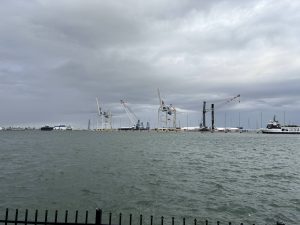
Blue Origin’s Jacklyn landing ship on the left, B1080 in the middle; Doug (fairing recovery ship) on the right.
Apparently there was a third booster hidden behind JRTI which we couldn’t even see, laying on it’s side. Busy place!
Boosters we saw in port:
- B1080-12 after Starlink 6-69
- B1076-18 after Starlink 6-68
Viewing from Kennedy Space Center
KSC advertises launch viewing heavily, but it was confusing to me before we actually got there.
The main KSC visitor complex has a “launch viewing area” but it doesn’t offer pad views. If you happen to be at KSC, you’ll enjoy it, but I wouldn’t go out of my way to view from here.
Viewing from the Saturn V center is quite different – a much better view. But it’s at the other side of a bus ride. P ay attention to the timing – the last bus to the Saturn V center from the main visitor complex is at 2:30 PM, and the Saturn V center closes at 4:00 PM. We were aiming for a 4:02 PM launch and got conflicting reports from staff on whether we’d be allowed to stay. In the end, the launch was postponed to 4:28 PM, and while the staff closed all the exhibits and food at 4PM, they let us linger outside and then ride buses back after the launch was over. I think had the launch been postponed much later, they would’ve sent us packing.
This view was great, although there are two sets of stands and the Banana Creek stands which are not always open were not available to us – those would have provided a better view, but are only open on certain occasions. We stood on the grass lawn and had a great view regardless, despite people waiting until T+10 seconds to decide to stand in front of us and hold their phones up in the air.

Panoramic view from KSC Saturn V center. You can in fact see SLC-40 from here; it was just behind a bush when I snapped this photo. You can also see LC-39B off to the left.
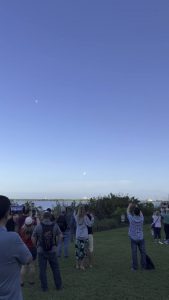
Launch of Starlink 6-69 from SLC-40. No zoom lens for this launch; I forgot it in the car! We just enjoyed the view and the sounds without too much technology.
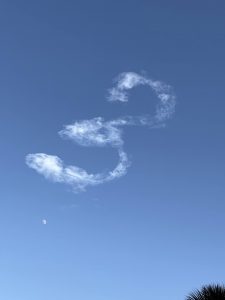
The rocket contrail was blown by upper-level winds into the shape of a 3 which made my three year old son very happy!
Launch we saw from here: Mon Nov 11, 2024 – Falcon 9 – Starlink 6-69
Worth Mention: Playalinda Beach
I think Playalinda is the intersection of most accessible “close” viewing spot + rather simple public access + SpaceX’s choice of LC-39A viewing to get as close as possible (around 3 miles away) from an everyday Falcon 9 launch. Unfortunately we didn’t get to experience this – the one time we tried to go to Playalinda, it was closed. It became apparent that we were in a line of cars all going to this beach for the launch, and annoyingly we didn’t find out it was closed until we were 15 minutes out of Titusville around here.
Experience with scheduling
Launches are often scheduled for one date, postponed back 24 hours at a time, and many launches have a window of time during which to launch – and don’t always hit the start time. Falcon 9 in particular has a go/no-go for propellant loading – the primary decision point – at about T-39 minutes. If a launch is going to be postponed, the new time is usually updated in Next Spaceflight about 30 minutes out from the originally scheduled time.
At about a week out from our vacation starting November 9th, there were only two launches on the Next Spaceflight schedule:
In the week leading up to the trip, two Starlink launches and the GSAT-20 launch were added. And while they all slipped a day or more, we saw them all!
Our experience, by launch:
- Starlink 6-69 – was originally scheduled for the Saturday we flew into Orlando. Then bumped to Sunday evening at 5PM with a launch window going to ~8 PM. The launch got bumped back to 8PM in the afternoon and at dinner around 7PM got bumped to the following day at 4:02 PM. While at the Saturn V center, it was bumped back an additional ~30 minutes to about 4:30 PM before lifting off.
- Koreasat 6a was on the schedule early for Monday the 11th and stuck to it. Originally it was listed as “NET November 11” and eventually got the time slot of 11:07 AM. The launch was bumped back only a few minutes to 11:22 AM with about an hour of notice.
- Starlink 6-68 – was originally scheduled for Monday November 11th at ~5:45 AM. It was pushed back to Tuesday, and then to Thursday when it finally launched. Each time it was pushed back, the opening window moved forward about 10-15 minutes. The launch had a several hour long launch window. It also changed launch pads between LC-39A and SLC-40. On launch day the window was set to open at 5:15 AM; an hour before this it was bumped to ~5:30; at T-5 minutes we learned that the new launch time was 8:21 AM, which is when it finally launched.
- Optus-X/TD7 was also on the schedule early for November 17th, but did not get a launch window as early as Koreasat 6a. The launch window opened at 4:28 PM and about an hour out we learned it was bumped to 4:58 PM, and shortly thereafter to 5:28 PM which was the actual launch time. 5:28 PM is way better – the sun had mostly set, and the view was more brilliant!
- GSAT-20 was added to the schedule a bit later than Koreasat 6a and Optus-X but I don’t remember when. It was slated for Sunday November 17th, but got bumped back to Monday November 18th which was our last day in town. If I recall correctly, the launch window opened at 1:15 PM, but an hour out from launch it was bumped to 1:31 PM.
Moral of the story: the schedule is always changing, but if you keep up with it, you’ll get to see stuff!
Why go see a rocket launch?
It’s true, we’re incredibly spoiled with 4K HD views on YouTube in our pockets of launch pads around the world. For big launches like Starship, I often have two or three stream going to watch the epic launch from multiple angles. But there are four things you can’t get on a launch stream:
- The light: The fire isn’t orange; it isn’t yellow: it’s just bright. Looking at a rocket engine firing is like looking at a mini sun. It’s not bright enough to make you need to look away, however a computer screen can’t reproduce the sheer intensity of the light you’re seeing. It’s absolutely beautiful.
- The sound. It’s incredible. At ~10 miles away, the sound is delayed by ~45 seconds from what you see, which is surreal. But when it hits you, there’s nothing like it short of watching the Blue Angels flying overhead. I’ve never heard & felt anything like it in my life.
- The crowd: you’re never alone looking at a launch. You’ll often find a couple of folks obliviously fishing, but the nerds huddled around their phones are there to watch the launch. Go say hi, you’ll meet cool people. There are serious photographers too, like the folks from US Launch Report whose trailer-mounted telescoping camera was worth a photo itself. Every single person I met was excited and nice.
- The excitement: watching a launch on YouTube isn’t as exciting. You can pause the video mid-launch and go get a coffee. In real life, when the launch is delayed by 30 minutes, it’s different. When the launch goes off, people gasp and “ooh”. So do you. You’ll feel like a kid again, I promise.
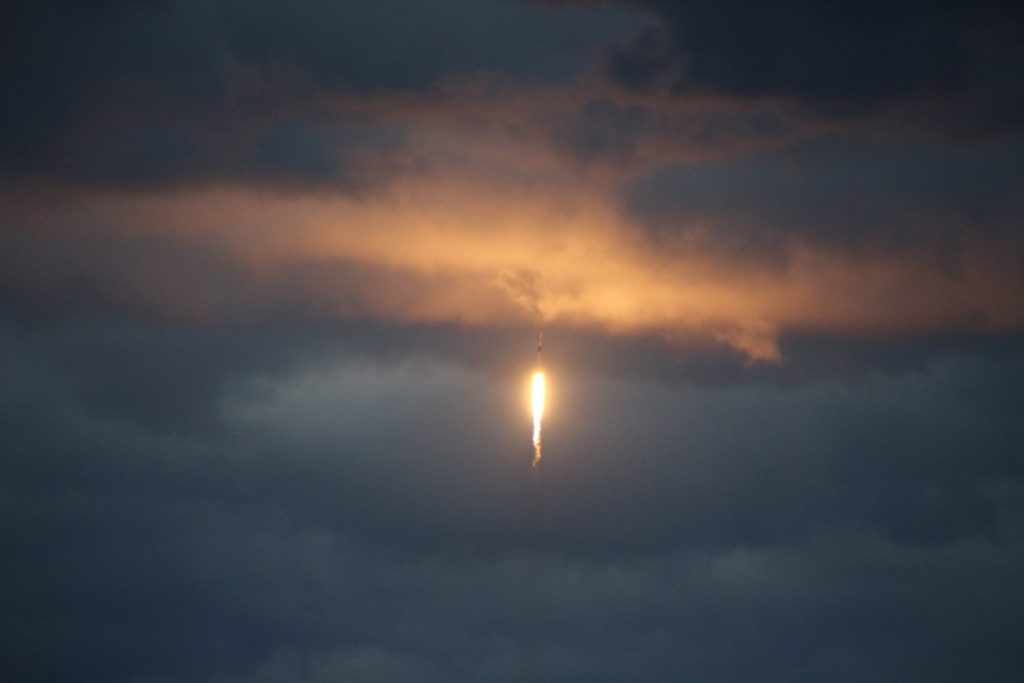
Happy viewing, folks!

